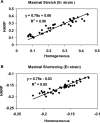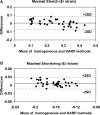Measurement of strain in physical models of brain injury: a method based on HARP analysis of tagged magnetic resonance images (MRI)
- PMID: 15543872
- PMCID: PMC2408558
- DOI: 10.1115/1.1785811
Measurement of strain in physical models of brain injury: a method based on HARP analysis of tagged magnetic resonance images (MRI)
Abstract
Two-dimensional (2-D) strain fields were estimated non-invasively in two simple experimental models of closed-head brain injury. In the first experimental model, shear deformation of a gel was induced by angular acceleration of its spherical container In the second model the brain of a euthanized rat pup was deformed by indentation of its skull. Tagged magnetic resonance images (MRI) were obtained by gated image acquisition during repeated motion. Harmonic phase (HARP) images corresponding to the spectral peaks of the original tagged MRI were obtained, following procedures proposed by Osman, McVeigh and Prince. Two methods of HARP strain analysis were applied, one based on the displacement of tag line intersections, and the other based on the gradient of harmonic phase. Strain analysis procedures were also validated on simulated images of deformed grids. Results show that it is possible to visualize deformation and to quantify strain efficiently in animal models of closed head injury.
Figures









References
-
- Zerhouni EA, Parish DM, Rogers WJ, Yang A, Shapiro EP. Human heart: tagging with MR imaging--a method for noninvasive assessment of myocardial motion. Radiology. 1988;169:59–63. - PubMed
-
- Axel L, Dougherty L. Heart wall motion: improved method of spatial modulation of magnetization for MR imaging. Radiology. 1989;172:349–350. - PubMed
-
- Axel L, Dougherty L. MR imaging of motion with spatial modulation of magnetization. Radiology. 1989;171:841–845. - PubMed
-
- Rademakers FE, Rogers WJ, Guier WH, Hutchins GM, Siu CO, Weisfeldt ML, Weiss JL, Shapiro EP. Relation of regional cross-fiber shortening to wall thickening in the intact heart. Three-dimensional strain analysis by NMR tagging. Circulation. 1994;89:1174–1182. - PubMed
Publication types
MeSH terms
Grants and funding
LinkOut - more resources
Full Text Sources
Medical

